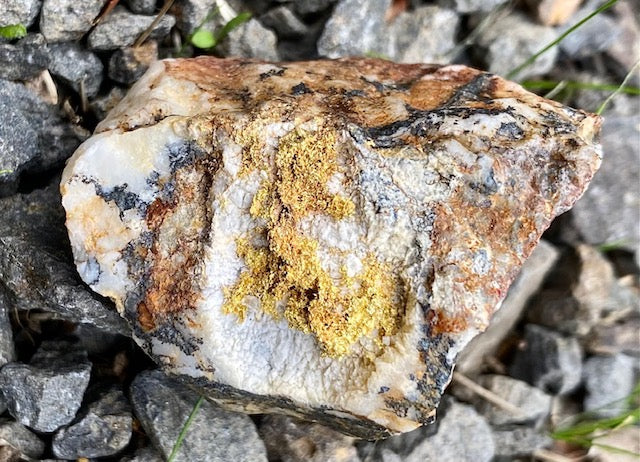
A Guide To Metal Detecting For Gold Nuggets
Tips For Metal Detecting For Gold Nuggets
You’ve got the gold fever, you start to daydream of wandering out into the wilderness where no other man has been, and metal detecting gold nuggets as plentiful as any other location on earth. You look on Google earth, “that doesn’t look so bad, I can hike through that” you say to yourself.
You get in your car and drive to the location and suddenly go into shock. You’re in the middle of nowhere, with miles of nothing around you, and you have no clue where to begin. It would take a lifetime to detect.
Man has explored for gold in more places than you could imagine, and luckily much of this has been recorded on geological survey maps, or specific topo-maps that show old mining sites. It only takes a little research to find a spot where gold has been found before, or where rocks and minerals have been found that are often associated and found with gold.
For instance, iron, copper pyrite, galena, magnetite, lead, quartz, and calcite just to name a few.

Let’s say you want to go Rambo and find a place where gold actually hasn’t been mined before. Some would call this “patch hunting”, essentially you’re looking to metal detect virgin ground. First, you still need to do your research. Go to Mindat.org to look for minerals associated with gold that have been found in the area you will be searching. Gold is incredibly heavy, so the moment it leaves its source, it travels downward until it gets trapped or hits bedrock.
Keeping in mind gold’s downward journey, it might be advantageous to go on Google earth and topo maps to search for land features that could potentially hold gold. An excellent topo map app is called “Topo Maps”. When you look for it in your app. store, it should be an illustration of a topo map with a blue-headed pin stuck in the middle of it. It’s free!
ONX Maps is another excellent Topo map and maps app., however, it costs money. The reason why ONX Maps is so incredible is that it will show you all the property owners and property lines along with contact information for who owns the property so you never get into trouble going on someone else's land. The link for ONX Maps is HERE.

Features to look for when detecting for gold:
- Color changes, or iron staining in the hills or dirt.
- Quartz vein outcrops.
- Contact and fault zones.
- Road cuts and rockslides on mountains.
- Gravel bars, high benches and inside bends of rivers and streams.
- Large, well-worn boulder patches that might suggest an ancient river bed.

Searching large areas where gold has not yet been found requires you to cover a lot of ground fast. This means you’ll need to swing a little bit faster until you find a nugget, and then slow way down to check to see if there are others nearby. Gold nuggets can sometimes come in patches, once you find one, there is a good chance others are nearby. Use a gridding or spiralling technique as you move out from the source nugget.
If you’re on a hillside, you can go up towards where you think the source of the nugget may have come from, or you can travel down to where other nuggets may have fallen from the same source.
Most sources will encourage you to look for gold where it has already been found before instead of trying to be Rambo and go out into the wilderness swinging your detector until you throw your arms up in exhaustion or get eaten by a bear.

Using the Mindat site,Topo Map, and other resources, you can find old mining sites, and areas that have been prospected and yielded gold before. In this case you should be looking for:
- Old mines and mine shafts. (Be careful! Do not enter old mine shafts and beware of hidden mine shafts).
- Hydraulic pits where gold was blasted out by water force, or large cuts in a hillside where the miners removed a rich gold vein. It might be wise to dig a trench at the base of these pits, or scrape off a layer of topsoil, this will help yield new material if the site has already been worked.
- Dredging or drywashing tailings. These are piles of rocks that went through sluices and trommels or were too large to go through. Searching these discarded tailings piles can be rewarding, especially if you do the work of digging through them to get deeper into the pile that are less likely to have been detected before.
- Piles of rocks that are stacked along a stream can be an excellent indicator that the miners were working in that area. However, many experts advise against detecting piles of rocks stacked too perfectly as they point to the fact the Chinese were extremely efficient and would have cleaned up all the gold in that area. It never hurts to try though!
- Piles of larger boulders or chunks of larger ridged bedrock that were left behind by the old timers are an excellent place to detect, larger gold can tend to travel with larger rocks.

Tips for detecting gold in creeks and rivers:
- The first tip everyone will give you is to look on the inside bends of rivers and creeks. Inside bends are the bends that protrude into the creek, and usually have gravel bars.
- Gold will also get trapped under large boulders, tree roots, moss, boil holes, and in bedrock cracks and crevices. Be sure that the crevice is angled in such a way that the gold could not easily escape (perpendicular to the water flow for instance), otherwise the crevice might not be suited for trapping gold.
- Where streams and rivers narrow into canyons, you can find benches where the water level is high in the winter. If there are good bedrock crevices and gold traps along these benches then it is definitely worth searching high and low.
- Look along the walls of the stream or river for packed gravel, this might indicate an intersecting ancient channel where gravel was deposited long ago.
- Look for the part of the stream that levels out after a steep rapids or waterfalls, this would be an area gold might settle if the bedrock is not too deep.
- Look for indications of quartz, black sand, red iron mineralization, or any rocks and minerals found with gold.

All metal detectors can be used for hunting gold nuggets, however some are specifically designed to cut through the high levels of mineralization that are associated with gold. Here are some of the best detectors for finding gold nuggets, click the detector to read more details about it.
- Minelab GPZ 7000.
- Minelab GPX 5000.
- Minelab SDC 2300.
- Garrett ATX.
- Minelab Goldmonster 1000.
- Minelab Equinox 800.
- Garrett AT Gold.
- Fisher Gold Bug II.
- XP Deus.
- Whites Surfmaster PI Dual Field.
- Minelab Excaliber II .
Books:
Click Here For Books On Where To Find Gold!
Other resources:
https://www.askjeffwilliams.com/


